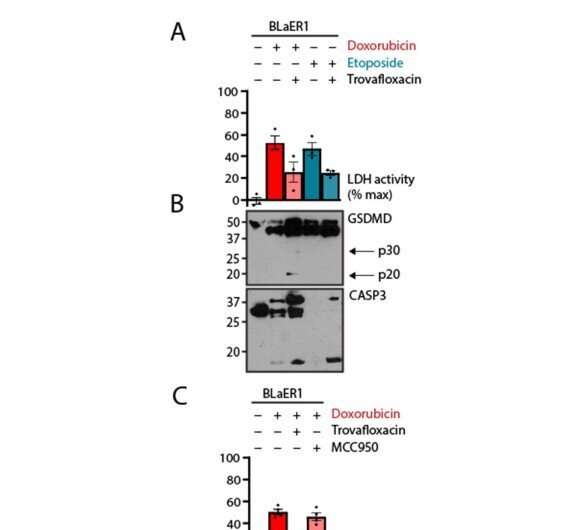How cancer cells die: Scientists explore new pathways of pyroptosis, killer kin of apoptosis

For anyone who has taken Biology 101, the concept of apoptosis—programmed cell death—is taught early in the course. You can’t understand the life cycle of a cell without learning how they die.
What’s usually not taught in Bio 101 is another way that cells die, a process called pyroptosis, an inflammatory and necrotic form of cell death that primarily involves cancer cells. During chemotherapy, apoptosis can morph into pyroptosis. For patients receiving chemo, apoptosis not only turns into pyroptosis, the process can help activate the immune system. Both the initiation of pyroptosis and activation of the immune system are mediated through specific protein pathways.
To date, most studies have connected chemotherapy-induced pyroptosis to a mediator protein called gasdermin E, which is typically thought of as the sole executioner in this process. Yet, an intriguing round of research has taken a deep dive into the process of pyroptosis, uncovering new molecular pathways that trigger this form of programmed cell death.
New discoveries have emerged from a novel series of investigations that challenge prevailing scientific wisdom about the way cells die under the influence of chemotherapy. The research sheds new light on pyroptosis in chemo-based cancer treatment by expanding the possible number of protein pathways involved in this form of cell death, and hinting that still other pathways may be found in the future.
Dr. Bowen Zhou, a pathologist at Case Western Reserve University’s School of Medicine, in Ohio, who led the new research, provides a practical lesson on pyroptosis, explaining that “in response to chemotherapy, the induction of apoptotic cell death can be converted to a form of lytic cell death called pyroptosis.”
The term “lytic cell death,” or “cell lysis,” refers to the breakdown of a cell caused by irrevocable damage to its outermost membrane. A cell can’t survive when its contents are spilling out through holes, and that’s what pyroptosis is all about. It’s bruising and violent—and aimed at cell death. During pyroptosis, a cascade of molecular reactions punch large pores in cell membranes, irrevocably destabilizing, and ultimately, destroying the cells.
The Case Western team further contends that for chemo to have an impact, it must trigger biological pathways that lead to cell death. The scientists’ elegant research, which includes analyses of blood and bone marrow biopsies from patients with acute myeloid leukemia, open a new window of understanding into the multiple pathways that pyroptosis can be triggered under the influence of chemo.
“Pyroptosis is a mechanism of programmed, necrotic cell death mediated by the gasdermins, a family of pore-forming proteins,” reports Zhou, lead author of the paper on pyroptosis in cancers of the blood. The research, published in the journal Science Signaling, highlights several pore-forming pathways that can lead to cell death under the influence of widely used chemotherapeutic agents.
In addition to their role in cancer-cell death via pyroptosis, pore-forming gasdermins are a family of proteins also implicated in the immune response. One of these proteins, gasdermin D, has held sway in cancer-cell death when induced by the formation of caspase-1–activating inflammasomes. But the story of pyroptosis apparently doesn’t begin and end with gasdermin D or or its close cousin, gasdermin E. It is a molecular saga that is far more complex than other studies have reported, scientists say.
“Caspase-1 activates gasdermin D under inflammatory conditions, whereas caspase-3 activates gasdermin E under apoptotic conditions, such as those induced by chemotherapy,” Zhou asserted. “These pathways are thought to be separate.
“However, we found that they are part of an integrated network of gatekeepers that enables pyroptotic cell death. We observed that gasdermin D was the primary pyroptotic mediator in cultured blood cells in response to doxorubicin and etoposide, two common chemotherapies for hematopoietic malignancies.”
As an aside, just to illustrate how complex gasdermins are in health and disease, another gasdermin protein, gasdermin A, along with gasdermin D, additionally have been implicated in autoimmune diseases and certain cancers. Yet, as reported in intricate detail in the Case Western study, gasdermin proteins are noteworthy for their pore-forming capabilities, particularly under the influence of chemotherapy.
The research by Zhou and colleagues offers fresh insight into pyroptotic pathways by uncovering multiple routes to cancer-cell death—a contrarian stance to prevailing scientific wisdom. Even though a high abundance of gasdermin E had a dominant effect, the conversion to pyroptosis in human myeloid cells could be independently mediated via the transmembrane protein pannexin-1, a channel also known as PANX1. This occurred either through the induction of an alternate pyroptotic pathway dependent on gasdermin D or independent entirely of gasdermins.
In blood and bone marrow biopsies from 15 leukemia patients, the relative abundance of gasdermin E, gasdermin D, and PANX1 predicted which pathway would mediate pyroptotic cell death in response to chemotherapy exposure.
The take home message from the study is multifocal: Cancer cells don’t simply die just because they’ve been exposed to chemo. They die through a programmed mechanism that can proceed through any one of several signaling pathways. Zhou and colleagues also have soundly demonstrated that pyroptosis during chemotherapy doesn’t rely solely on gasdermin E. Studying human myeloid cells exposed to chemo, the scientists found that pyroptosis can also proceed through PANX1. And even in the face of dogma-challenging research, there may be other pore-forming pathways that have yet to be found.
“Moving forward, it will be critical to carefully dissect the role of pore-forming proteins, including those not yet implicated, in hematologic and perhaps other malignancies to tailor an appropriate therapeutic response,” Zhou concluded.
More information:
Bowen Zhou et al, Gasdermins and pannexin-1 mediate pathways of chemotherapy-induced cell lysis in hematopoietic malignancies, Science Signaling (2022). DOI: 10.1126/scisignal.abl6781
Journal information:
Science Signaling
Source: Read Full Article
